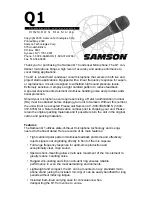
10
Receiver is not on (LCD window does not light).
• Receiver Power switch is not pressed in.
• Small DC power cord from included in-line power supply
is not plugged into jack on back of receiver.
• The power supply is not plugged into AC power
outlet.
• AC power is not present at the AC outlet.
Receiver is on (LCD window lights)
•
No sound:
✓
“RF”
and
"AF"
level meters both show good signals.
• AF Level control on front of receiver not turned up
(clockwise). [See p. 4.]
Note: If the
“AF”
level meter shows a good signal on the
receiver when the transmitter is receiving audio input,
and the AF Level control is turned up, then the problem
is in connections to, or control settings on the mixer,
amplifier, etc.
✓
Only
“RF”
level meter shows good signal; no
“AF”
signal.
• No sound input to mic.
• ATW-T161 body-pack only: Wrong input trim selected
(
“GT”
or
“MIC”
). [See p. 5.]
Receiver is on (LCD window lights)
•
No sound:
✓
“RF”
and
“AF”
level meters both show good signals.
• The transmitter audio level is too high
[See p. 4 & 5]
✓
Neither the
“RF”
nor the
“AF”
level meter shows any
signal.
• Receiver antennas not connected.
• Transmitter is turned off.
• Transmitter is set to a different frequency.
• Transmitter batteries are dead or missing.
Receiver is on (LCD window lights)
•
Distorted sound:
✓
“RF”
and/or
“AF”
level meters may show good signals.
• The transmitter audio level is too high.
[See p. 6 & 7.]
• Received RF level may be too low (only one or two bars).
• Batteries may be weak; check
“BATT”
condition
indicator.
[See p. 5]
Troubleshooting Guide
Momentary loss of sound/noisy sound as transmitter is
moved around performing area.
• Transmitter and receiver antennas not in line-of-sight
(or perhaps too far apart). Adjust positions of units so
they are visible to each other/closer together.
If problem persists. use remote antennas located closer
to the transmitter location.
• Signal blockage or interference from large metal objects,
other wireless units located too close and/or on
incompatible frequencies, computer or lighting
equipment.
• Squelch setting may be set “tighter” than it needs to
be.
[See p. 6]
With transmitter on, received signal is noisy or contains
extraneous sounds.
• Batteries may be weak. Check
“Battery condition
indicator
and
“RF”
meter level.
• Local TV transmissions on this frequency.
• Nearby sources of RF interference, such as computers,
lighting equipment, etc.
• Two transmitters may be operating on the same
frequency. Locate and turn one off or change its
frequency.
• In multiple-system use, two (or more) incompatible
frequencies may have been selected. Refer to the
suggested multi-channel frequency combinations.
on supplement sheet,


































